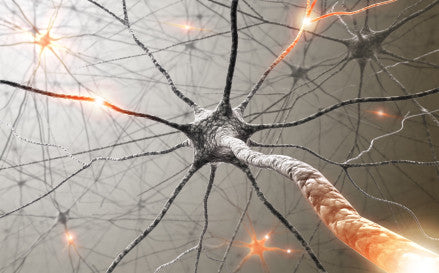
Can Damaged Nerves Regenerate? New Research Finds Answers!
Share
Yes. However, understanding the complexities involved in nerve regeneration is a mystery that is still unraveling, but it is starting to become a little clearer for scientist and researchers.
As the focus narrows on what can be done to regenerate damaged nerves and reverse painful neuropathy, several key players emerge. In this article, we will briefly cover a few of those key players, how their roles interact, and what products are available that contain these ingredients.
Axons - Axons are, in effect, the primary transmission lines of the nervous system and as bundles they help make up the nerves. The longest axons in the human body, for example, are those of the sciatic nerve, which run from the base of the spine to the big toe of each foot.
Axon dysfunction has caused many inherited and acquired neurological disorders which can affect both the peripheral and central neurons.
Axons carry signals in the form of action potentials, which are discrete electrochemical impulses that travel rapidly along an axon, starting at the cell body and terminating at points where the axon makes synaptic contact with target cells. When an action potential reaches a presynaptic terminal, it activates the synaptic transmission process. The first step is rapid opening of calcium ion channels in the membrane of the axon, allowing calcium ions to flow inward across the membrane. The resulting increase in intracellular calcium concentration causes vesicles (tiny containers enclosed by a lipid membrane) filled with a neurotransmitter chemical to fuse with the axon's membrane and empty their contents into the extracellular space. The neurotransmitter is released from the presynaptic nerve through exocytosis. This entire sequence of events often takes place in less than a thousandth of a second. Afterward, inside the presynaptic terminal, a new set of vesicles are moved into position next to the membrane, ready to be released when the next action potential arrives. The action potential is the final electrical step in the integration of synaptic messages at the scale of the neuron.
Schwann cells - create the insulating myelin sheath that speeds transmission of nerve impulses. In repair mode, Schwann cells form a fix-up crew that adds house cleaning and stimulation of nerve regrowth to the usual insulating job. Schwann cells are named after German physiologist Theodor Schwann, who discovered them in the 19th century. Abnormalities reported in diabetic neuropathy include axonal degeneration in nerve fibers, and primary demyelination resulting from Schwann cell dysfunction.
So, how do we keep the Schwann cells functioning properly and in repair mode when they need to be? Certain amino acids interact with Schwann Cells to trigger biological responses. Below are key ingredients that support Schwann Cell metabolism and regeneration of damaged nerves.
Taurine – Taurine is a sulfur-containing, free amino acid that has multiple putative metabolic functions including that of an antioxidant. Taurine exerts a variety of biological actions, including antioxidation, modulation of ion movement, osmoregulation, modulation of neurotransmitters, and conjugation of bile acids which may maintain physiological homeostasis. Recently, data is accumulating that show the effectiveness of taurine against diabetes mellitus and insulin resistance, along with its complications, including retinopathy, nephropathy, and neuropathy.
Taurine treatment has been found to reduce lipid peroxidation and attenuate deficits of nerve conduction, dorsal root ganglion neuron calcium signaling, endoneurial blood flow, and hyperalgesia.
Recent data suggest taurine supplementation as well as strategies directed toward prevention of taurine depletion as potential therapies to help prevent or reverse diabetic neuropathy.
Since taurine depletion has been demonstrated in blood samples of patients with type 1 and type 2 diabetes as well as in the peripheral nerve, a dietary supplement containing taurine is recommended. (The potential usefulness of taurine on diabetes mellitus and its complications). https://www.ncbi.nlm.nih.gov/pmc/articles/PMC3325402/
Acetyl L Carnatine (ALCAR) - ALCR treatment is efficacious in alleviating symptoms, particularly pain, and improves nerve fiber regeneration and vibration perception in patients with established diabetic neuropathy. (American Diabetes Association, Diabetes Care) http://care.diabetesjournals.org/content/28/1/89.long
Most of the cells in your body contain carnitine, which is made by the liver and kidneys. Carnitine helps your cells produce energy. Acetyl-L-carnitine (ALCR) is a form of carnitine that's available as a supplement.
L-Carnitine and the related compound Acetyl-L-Carnitine (ALCAR) are compounds able to alleviate the effects of aging and disease on the mitochondria, while increasing the mitochondria’s potential to burn fat. ALCAR is often used as a brain booster, due to its ability to increase alertness and mitochondrial capacity while providing support for the neurons.
ALCAR has been shown to be very effective at alleviating the side effects of aging, such as neurological decline and chronic fatigue. ALCAR supplementation is also a very safe method of improving insulin sensitivity and blood vessel health, particularly for people with delicate or weakened cardiac health. ALCAR can also protect neurons and repair certain damage, such as that caused by diabetes and diabetic neuropathy. (Examine.com) https://examine.com/supplements/l-carnitine/
L-Citrulline - is better than L-Arginine for activating Nitric Oxide (NO). Most supplements for nerve health use L-Arginine for vasodilatation and to increase NO levels. However, recent studies demonstrate that L-Citrulline is better than L-Arginine at increasing NO levels. This is very important because NO mediated vasodilation will increase delivery of oxygen and nutrients to poorly perfused nerves to re-establish their normal membrane potential. (Pharmacokinetic and pharmacodynamic properties of oral L-citrulline and L-arginine: impact on nitric oxide metabolism) https://www.ncbi.nlm.nih.gov/pmc/articles/PMC2291275/
Methylcobalamin (B12) – The human body needs vitamin B12 to make red blood cells, nerves, DNA, and to carry out other functions. However, like most vitamins, B12 can’t be made by the body. Instead, it must be gotten from food or supplements. While most people don’t consume enough vitamin B12 to meet their needs, the biggest problem for most type 2 diabetics is they can’t absorb enough, no matter how much they take in. As a result, vitamin B12 deficiency is relatively common, especially among older people. Additionally, medications commonly used to treat diabetes, such as Metformin, can cause B12 deficiency and neuropathy. For years, Metformin was recommended as initial therapy for type 2 diabetes. Recent studies have shown that chronic Metformin use results in vitamin B12 deficiency in 30% of patients. Exhaustion of vitamin B12 stores usually occurs after twelve to fifteen years of absolute vitamin B12 deficiency.
In a recent study it was noted by Jill Crandall, MD, professor of clinical medicine at the Albert Einstein College of Medicine ''has implications for the consequences of B12 deficiency." These can include cognitive impairment, nerve problems (neuropathy) and anemia (low red blood cell count). B12 is crucial for the proper formation of red blood cells, for neurological functioning and for making DNA. Years of use was linked with an increased risk of B12 deficiency, Dr. Crandall found. Those taking metformin were more likely to have anemia, regardless of their B12 status. Those taking metformin with low B12 were more likely to have neuropathy. (endocrineweb.com) https://www.endocrineweb.com/news/diabetes/20265-long-term-metformin-use-linked-vitamin-b12-deficiency
B12 has also been called a “potential vitamin of pain killer” it exerts neuronal protection by promoting regeneration of injured nerves and antagonizing glutamate-induced neurotoxicity. Recently several lines of evidence demonstrated that B12 may have potential analgesic effects in experimental and clinical studies. For example, B12 alleviated pain behaviors in diabetic neuropathy, low back pain and neuralgia. B12 improved nerve conduction, promoted the regeneration of injured nerves, and inhibited ectopic spontaneous discharges of injured primary sensory neurons.
Beta-alanine (B-alanine) – Is used for improving athletic performance and exercise capacity, building lean muscle mass, and improving physical functioning in the elderly. However, recent studies have shown the positive effects of B-alanine in treating neuropathy.
R-Alpha Lipoic Acid - R-alpha-lipoic acid (1, 2-dithiolane-3-pentanoic acid) was discovered in 1937 by Snell et al., who found that certain bacteria needed a compound from potato extract for growth. In 1951, the so-called potato-growth factor was isolated by Reed and colleagues, and lipoic acid was discovered as a molecule that assists in acyl-group transfer and as a co-enzyme in the Krebs cycle. In the 1980s, alpha-lipoic acid was recognized as a powerful antioxidant. It is the only fat- and water-soluble antioxidant. It is produced by animals and humans, and can be found in liver, skeletal muscle, potatoes, and broccoli. Nutritional supplements of alpha-lipoic acid are typically comprised either of R-alpha-lipoic acid alone or a racemic mixture of R-alpha-lipoic acid and S-alpha-lipoic acid.
Diabetic patients with neuropathy treated with alpha-lipoic acid 600 mg i.v. daily for three weeks, have reduced pain, paresthesias, and numbness. According to a recent meta-analysis comprising 1,258 patients, the same treatment ameliorated neuropathic symptoms and deficits after three weeks. Acute infusion of alpha-lipoic acid improved nitric oxide-mediated endothelium-dependent vasodilation in diabetic patients, and improved microcirculation in patients with diabetic polyneuropathy. (Alpha-Lipoic Acid and Diabetic Neuropathy) https://www.ncbi.nlm.nih.gov/pmc/articles/PMC2836194/
The below chart contains a list of popular nerve support and neuropathy supplements and how many of these key ingredients each contains:

